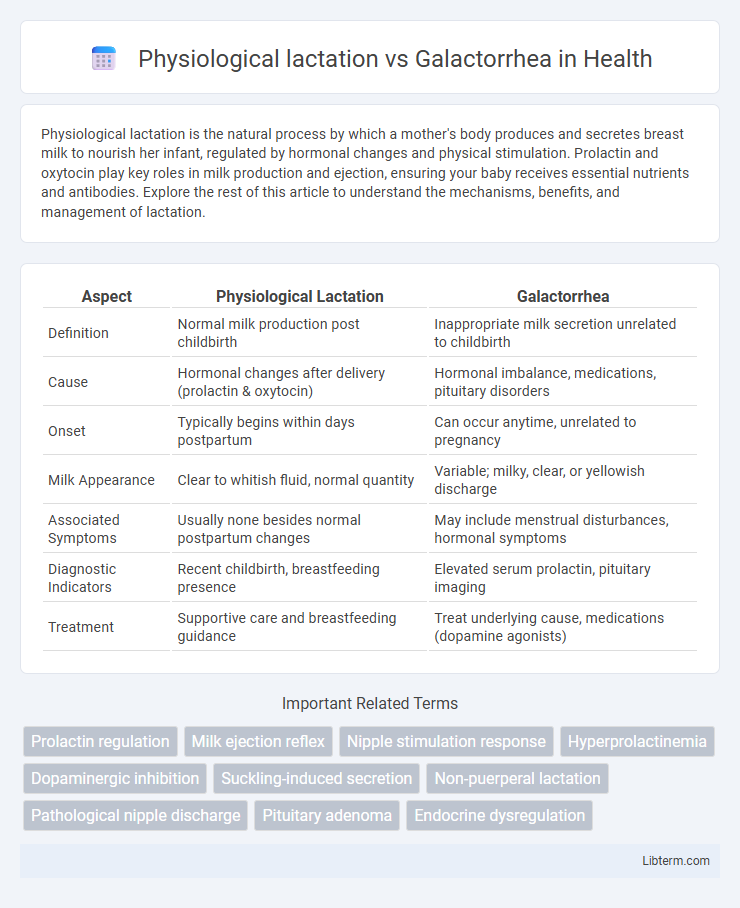Physiological lactation is the natural process by which a mother's body produces and secretes breast milk to nourish her infant, regulated by hormonal changes and physical stimulation. Prolactin and oxytocin play key roles in milk production and ejection, ensuring your baby receives essential nutrients and antibodies. Explore the rest of this article to understand the mechanisms, benefits, and management of lactation.
Table of Comparison
| Aspect | Physiological Lactation | Galactorrhea |
|---|---|---|
| Definition | Normal milk production post childbirth | Inappropriate milk secretion unrelated to childbirth |
| Cause | Hormonal changes after delivery (prolactin & oxytocin) | Hormonal imbalance, medications, pituitary disorders |
| Onset | Typically begins within days postpartum | Can occur anytime, unrelated to pregnancy |
| Milk Appearance | Clear to whitish fluid, normal quantity | Variable; milky, clear, or yellowish discharge |
| Associated Symptoms | Usually none besides normal postpartum changes | May include menstrual disturbances, hormonal symptoms |
| Diagnostic Indicators | Recent childbirth, breastfeeding presence | Elevated serum prolactin, pituitary imaging |
| Treatment | Supportive care and breastfeeding guidance | Treat underlying cause, medications (dopamine agonists) |
Understanding Lactation: Physiological vs. Pathological
Physiological lactation is the natural production of breast milk triggered by hormonal changes during pregnancy and postpartum, essential for newborn nutrition. Galactorrhea, a pathological condition, causes inappropriate or excessive milk secretion unrelated to childbirth, often associated with hormonal imbalances, medication side effects, or pituitary disorders. Differentiating between physiological lactation and galactorrhea requires assessing hormonal levels such as prolactin and evaluating underlying causes to ensure appropriate diagnosis and treatment.
The Physiology of Normal Lactation
Normal lactation involves the coordinated interaction of hormones such as prolactin, oxytocin, and estrogen, which regulate milk production and ejection from the mammary glands. Prolactin stimulates the alveolar cells to produce milk, while oxytocin triggers the contraction of myoepithelial cells for milk let-down, a process tightly controlled by the hypothalamic-pituitary axis. Galactorrhea, contrasting with physiological lactation, occurs due to abnormal prolactin secretion unrelated to childbirth or breastfeeding, often caused by pituitary disorders or medication effects.
Hormonal Regulation in Breast Milk Production
Physiological lactation is primarily regulated by the coordinated action of prolactin and oxytocin, where prolactin stimulates milk synthesis in mammary alveolar cells and oxytocin triggers milk ejection via myoepithelial cell contraction. Galactorrhea involves inappropriate milk production unrelated to childbirth or nursing, often caused by hyperprolactinemia due to pituitary adenomas, hypothyroidism, or dopamine antagonist medications disrupting dopamine's inhibitory effect on prolactin secretion. Both conditions highlight the critical role of hypothalamic-pituitary axis regulation, with dopamine serving as a key inhibitory hormone in maintaining prolactin balance for normal or pathological breast milk production.
What Is Galactorrhea? Definition and Overview
Galactorrhea is the spontaneous flow of milk from the breast, unrelated to normal breastfeeding or physiological lactation. It results from an imbalance of hormones such as prolactin, often caused by pituitary tumors, medications, or endocrine disorders. Unlike physiological lactation, which occurs postpartum to nourish an infant, galactorrhea indicates an underlying pathological condition requiring medical evaluation.
Key Differences Between Physiological Lactation and Galactorrhea
Physiological lactation is a natural process involving milk production triggered by hormonal changes during pregnancy and postpartum, primarily regulated by prolactin and oxytocin. Galactorrhea, in contrast, is an abnormal condition characterized by inappropriate milk secretion unrelated to childbirth or nursing, often caused by hormonal imbalances like hyperprolactinemia or pituitary tumors. Key differences include the cause, presence of pregnancy, and hormonal regulation, with physiological lactation being normal and expected, whereas galactorrhea indicates underlying pathological issues.
Common Causes of Galactorrhea
Physiological lactation occurs naturally during pregnancy and postpartum as a result of hormonal changes, primarily increased prolactin levels stimulating milk production. In contrast, galactorrhea is characterized by inappropriate milk secretion unrelated to childbirth or nursing, often caused by hyperprolactinemia, pituitary tumors (prolactinomas), hypothyroidism, certain medications like antipsychotics or antidepressants, and chest wall irritation. Distinguishing between physiological lactation and galactorrhea requires evaluation of underlying endocrine disorders and medication history to guide appropriate treatment.
Clinical Presentation: Galactorrhea Symptoms vs. Normal Lactation
Galactorrhea presents clinically as persistent, spontaneous milk secretion unrelated to childbirth or breastfeeding, often accompanied by menstrual irregularities and sometimes headaches or visual disturbances indicating possible pituitary adenomas. In contrast, physiological lactation occurs postpartum as a natural response to hormonal changes, with milk production typically stimulated by infant suckling and no associated pathological symptoms. Diagnostic evaluation focuses on distinguishing galactorrhea's abnormal hormone levels, such as elevated prolactin, from the normal hormonal profile seen in lactating women.
Diagnostic Approaches for Abnormal Breast Milk Secretion
Diagnostic approaches for abnormal breast milk secretion differentiate physiological lactation from galactorrhea through hormonal assays measuring prolactin, thyroid function tests, and imaging studies such as pituitary MRI. Clinical evaluation includes detailed patient history, assessing factors like pregnancy, breastfeeding status, and medication use that influence prolactin levels. Milk secretion without recent pregnancy or lactation suggests galactorrhea, warranting comprehensive endocrine workup to identify underlying causes.
Management and Treatment Strategies
Physiological lactation typically requires minimal intervention, focusing on breastfeeding support and ensuring proper infant latch and nutrition, while management of galactorrhea involves identifying underlying causes such as hyperprolactinemia, thyroid dysfunction, or medication side effects. Treatment strategies for galactorrhea may include dopamine agonists like bromocriptine or cabergoline to reduce prolactin levels, alongside addressing any pituitary tumors or hormonal imbalances. Regular monitoring of prolactin levels and imaging studies are essential for accurate diagnosis and tailoring appropriate therapy.
Preventive Measures and Patient Education
Physiological lactation occurs naturally postpartum and requires routine breast hygiene and proper breastfeeding techniques to prevent complications such as mastitis, while galactorrhea, often caused by hormonal imbalances or medications, necessitates identifying and managing underlying causes to prevent persistent or inappropriate milk secretion. Educating patients on recognizing normal vs. abnormal nipple discharge, maintaining breast care, and avoiding nipple stimulation can reduce the risk of galactorrhea and promote healthy lactation. Regular follow-up and communication about symptoms help ensure early intervention and appropriate treatment to manage both conditions effectively.
Physiological lactation Infographic

 libterm.com
libterm.com